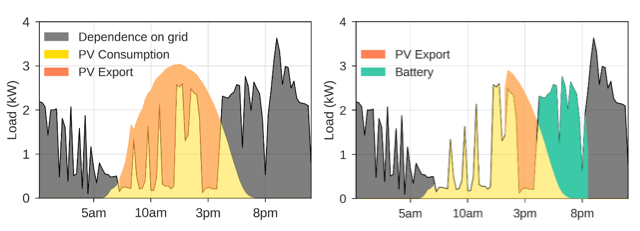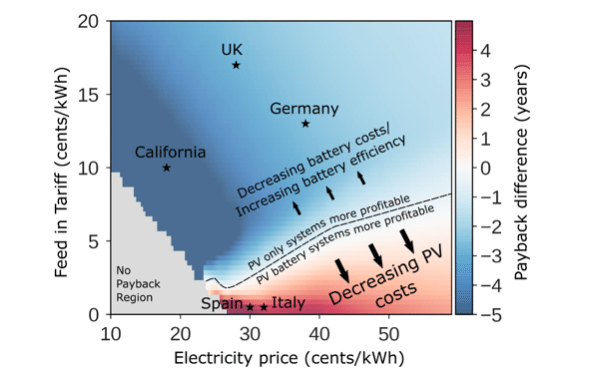
Batteries certainly have the potential to disrupt the way in which current electricity systems work, introducing distributed energy storage and allowing consumers across the network to take greater control over their electricity consumption patterns.
In particular, combining PV and battery systems at a household level is an important area of development, due to the mismatch between solar production and residential electricity use (see Figure 1). Furthermore, battery costs are declining, residential electricity prices are increasing and rewards for exported PV generation are falling, all contributing to the interest in batteries.

Figure 1: Illustrating the misalignment of residential electricity consumption and PV generation [left] and the potential effect of batteries [right]. (Credit: Edward Barbour)
The paper uses a data-driven modeling approach based on 15-minute electricity consumption and PV generation data from the Pecan Street Initiative [3], which is freely available for academic use. This allows a realistic model of the demand and generation for more than 350 consumers in three different US cities (Austin, Boulder, and San Diego) to be developed over a full year.
In the first part of the analysis, the relationship between battery size and self-sufficiency for all households is studied, so that each household can be assigned a battery size specific to their needs. This in itself yields interesting results; in general, there is very little benefit to installing a battery with more than 3 kWh of storage per MWh of yearly PV generation.
In the second part of the analysis, the paper investigates battery economics under a range of different electricity tariffs from the household regions. Both Feed In Tariff (FIT) and Net Energy Metering (NEM) support mechanisms for PV are considered. For each individual household under each tariff, the paper optimizes the battery operation explicitly to minimize the household electricity bill. With the tariffs considered, the average estimated Net Present Value (NPV) of PV systems with a 30 year lifetime ranged from approximately -$500/kW to $6,000/kW (the paper assumes PV costs of $3,500/kW, so NPV = $6000/kW implies that a PV system returns a profit of roughly 170% of its investment cost). However, for all tariffs, batteries had negative NPV and consumers were unable to recover the battery investment over the battery lifetime, with current battery installation costs.
Therefore, in the last part of the analysis, the paper studies the sensitivity of battery value to future electricity prices, also considering factors such as cost reductions in PV, battery price reductions and battery efficiency. By considering a range of electricity prices and FIT levels, the boundary between price regions where combined PV-battery systems are more profitable than PV-only systems for a majority of consumers is defined (see Figure 2). The paper finds that decreasing PV costs have a large effect shrinking the region where PV-battery systems are more profitable while decreasing battery costs and increasing battery efficiency expand the profitable region but have smaller impacts.
The findings suggest that combined PV-battery systems generally become profitable with electricity prices above $0.40/kWh and solar rewards as low as $0.05/kWh or below. Framing this in terms of current electricity prices and solar subsidies in different high solar international areas, most places have solar rewards that are too high for batteries to be economic. Currently, only Spain and Italy, where support for residential PV systems has collapsed, have electricity prices and subsidy levels where combined PV-battery systems are better investments than PV-only. However, given the steady declines in rewards for exported PV and increases in retail electricity prices, this may become true of other areas in future.

Figure 2: Comparing the difference in payback between PV-only and PV-battery systems for the average consumer. Payback difference = (Payback PV-only)-(Payback PV-battery). Average retail electricity prices and subsidy levels in different regions for the year 2015 are marked for context. (Credit: Edward Barbour)
The work is significant as it defines the electricity prices and subsidy levels at which a large deployment of household batteries may be expected, which is important for grid operators and utilities to understand. Importantly, household batteries also represent a significant embodied energy cost [4], so the paper highlights a need to understand other storage deployment levels (i.e. at a community, feeder, substation level, etc.) before any large-scale adoption of household batteries occurs.
These findings are described in the article entitled Projecting battery adoption in the prosumer era, recently published in the journal Applied Energy. This work was conducted by Edward Barbour and Marta C. González from the Massachusetts Institute of Technology.
References:
- Graebig, Markus, Georg Erdmann, and Stefan Röder. “Assessment of residential battery systems (RBS): profitability, perceived value proposition, and potential business models.” In 37th IAEE International Conference, vol. 25, pp. 1-15. 2014.
- Klingler, Anna-Lena. “Self-consumption with PV+ Battery systems: A market diffusion model considering individual consumer behaviour and preferences.” Applied Energy 205 (2017): 1560-1570.
- Rhodes, Joshua D., Charles R. Upshaw, Chioke B. Harris, Colin M. Meehan, David A. Walling, Paul A. Navrátil, Ariane L. Beck et al. “Experimental and data collection methods for a large-scale smart grid deployment: Methods and first results.” Energy 65 (2014): 462-471.
- Barnhart, Charles J., and Sally M. Benson. “On the importance of reducing the energetic and material demands of electrical energy storage.” Energy & Environmental Science 6, no. 4 (2013): 1083-1092.








